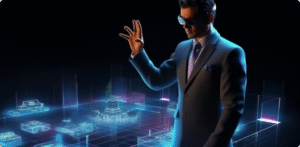
The Future of Online Retail: 7 Key E-commerce Development Trends for 2025

Global e-commerce is expected to grow by over 50% in the next few years, reaching trillions in sales. This incredible growth isn’t just about more people shopping online; it’s about a total transformation in how they shop. For businesses, the challenge is clear: keep up or get left behind.
Adapting to these rapid technological and behavioral shifts is now essential for survival. This guide breaks down the most important e-commerce trends for 2025. We’ll explore key strategies to help your business prepare for the future of online retail and build a stronger connection with your customers.
1. Immersive Commerce: The New Digital Storefront
Shopping online is moving beyond flat, 2D web pages. The future is about creating rich, interactive experiences that feel more like real life. Technologies like Augmented Reality (AR), Virtual Reality (VR), and the Metaverse are completely reshaping how customers discover and engage with products.
Augmented Reality (AR) for ‘Try Before You Buy’ Experiences
AR lets customers overlay digital products onto their real-world environment using their smartphone camera. Think of it as a virtual fitting room in your living room.
- Shoppers can see how a new sofa looks in their home.
- They can “try on” sunglasses or makeup without leaving the house.
- This removes guesswork, boosts buyer confidence, and reduces returns.
The Metaverse & Virtual Reality (VR) Showrooms (e.g., Nikeland on Roblox)
The metaverse is a shared virtual space where users can interact with each other and with brands. Companies are building virtual showrooms where customers can explore products in a fully 3D world. For example, Nike created Nikeland on the Roblox platform, a space for users to play games and interact with the brand in a fun, new way.
The Role of NFTs and Blockchain in Proving Digital Ownership (feat. Nike & RTFKT)
Blockchain technology and Non-Fungible Tokens (NFTs) are creating new ways to own digital items. When Nike acquired RTFKT, a digital sneaker company, it signaled a major move into this space. NFTs provide a secure certificate of ownership for virtual goods, like a unique pair of digital sneakers your avatar can wear in the metaverse.
2. AI-Powered Hyper-Personalization at Scale
Artificial Intelligence (AI) is no longer just for basic product recommendations. The new wave of e-commerce development uses AI to create unique, one-to-one shopping journeys for every single customer. It’s about making each person feel like the store was designed just for them.
How AI algorithms are revolutionizing product recommendations and search
AI looks at a customer’s browsing history, past purchases, and even what they’ve clicked on to show them products they’ll genui
nely love. It also powers smarter search functions that understand context, not just keywords, helping shoppers find exactly what they need, faster.
Dynamic Pricing and AI-driven personalized promotions
Have you ever seen a price change based on demand? That’s dynamic pricing. AI can adjust prices in real-time based on factors like competitor pricing, inventory levels, and customer behavior. It can also generate personalized discount codes and promotions, sent at the perfect moment to encourage a purchase.
The challenge of balancing personalization with customer data privacy
To personalize effectively, businesses need data. However, customers are more concerned about their privacy than ever before. The key is transparency. Brands must be clear about what data they collect and how they use it, giving customers control over their information to build trust.
3. Conversational & Social Commerce: Selling Where Customers Are
The lines between social media, messaging apps, and online shopping are blurring. The smartest e-commerce development strategy is to meet customers on the platforms they already use every day, like TikTok, Instagram, and WhatsApp, making the path to purchase seamless.
The evolution of AI Chatbots and Voice Assistants in customer service
Modern AI chatbots are available 24/7 to answer questions, track orders, and even guide customers through a sale. Voice assistants like Alexa and Google Assistant are also making it easier for people to shop with simple voice commands, creating a hands-free, convenient experience.
What is Social Commerce and why is it exploding?
Social commerce is the act of buying and selling products directly within a social media platform. Instead of clicking a link to an external website, users can complete their entire purchase on Instagram or Pinterest. It’s exploding because it’s fast, easy, and captures customers at their moment of inspiration.
Live Shopping: The Digital QVC (Examples: Walmart & TalkShopLive)
Live shopping is like a modern-day home shopping channel, hosted on social media or a brand’s website. A host demonstrates products in real-time, answers audience questions, and offers special deals. Major retailers like Walmart have partnered with platforms like TalkShopLive to engage with customers in this fun, interactive format.
4. Sustainable Commerce: The Rise of the Conscious Consumer
Today’s shoppers care about more than just price and quality. They want to know that the brands they support are ethical, transparent, and environmentally friendly. Sustainability and a company’s social governance (ESG) are becoming powerful factors in purchasing decisions.

Supply Chain Transparency as a key brand differentiator
Brands that are open about where their products come from and how they are made build immense trust. Are the materials ethically sourced? Are workers paid fairly? Answering these questions openly can set a brand apart from the competition. At ITXITPro, we see this as a core part of modern brand storytelling.
The growth of the Circular Economy and the Resale Market (e.g., Patagonia & ThredUp)
The circular economy is about reducing waste by reusing and reselling items. Brands like Patagonia encourage customers to trade in used gear through their partnership with resale platforms like ThredUp. This not only reduces landfill waste but also attracts environmentally conscious buyers.
How to effectively communicate your brand’s sustainability efforts
Don’t just be sustainable—talk about it. Share your brand’s ESG goals and progress on your website, social media, and product packaging. Be honest and avoid “greenwashing” (making false environmental claims). Authentic communication is key.
5. Convenient Commerce: Redefining Speed and Flexibility
In the world of online retail, convenience is king. E-commerce technology trends are all focused on making shopping faster, easier, and more flexible. This means giving customers more options for how they receive their orders and seamlessly blending online and physical shopping.
The Omnichannel Imperative: BOPIS (Buy Online, Pick-up In-Store) and Curbside Pickup
Omnichannel retail means creating a unified experience across all channels. BOPIS (Buy Online, Pick-up In-Store) and curbside pickup are perfect examples. They give customers the speed of online shopping combined with the instant gratification of getting their product the same day.
The Last-Mile Delivery Revolution and Quick Commerce (q-commerce)
The “last mile” is the final step of getting an order from a warehouse to a customer’s door. Quick commerce, or q-commerce, is focused on making this step incredibly fast—often within an hour. This is transforming customer expectations for everything from groceries to electronics.
The continued growth of Direct-to-Consumer (DTC) and subscription models
DTC brands sell directly to their customers, cutting out traditional retailers. This gives them more control over their brand message and customer relationships. Subscription models, which deliver products on a recurring schedule, offer ultimate convenience and create a predictable revenue stream.
6. Composable Commerce: Building for Agility
This is a more technical trend, but it’s crucial for the future of e-commerce development. Businesses are moving away from rigid, all-in-one platforms. Instead, they are adopting flexible, API-first systems that allow them to quickly adapt and innovate.
What is headless commerce and why does it matter for the future of online retail?
Headless commerce separates the front-end of an online store (the “head,” or what customers see) from the back-end (the e-commerce engine). This separation allows developers to create unique customer experiences on any platform—from a website to a smart mirror—without being limited by the back-end system.
Benefits of a composable architecture for future-proofing your business
A composable approach is like building with LEGOs. Businesses can pick and choose the best tools for different functions (like search, checkout, or payments) and plug them together. This makes it much easier to add new features or swap out old technology, ensuring the business can always stay current.
Key platforms and technologies leading the Digital Transformation
Platforms that support a composable or headless approach are leading this digital transformation. They give businesses the agility needed to respond to new e-commerce trends and integrate new technologies like AR or voice assistants without overhauling their entire system.
7. How to Prepare Your Business for the Future of E-commerce
Knowing the trends is one thing; acting on them is another. Here is an actionable plan to help you leverage these e-commerce development insights for growth in 2025. This is the kind of strategic thinking that ITXITPro helps businesses implement every day.

Conducting a digital maturity and technology audit
Start by evaluating your current technology. Is your e-commerce platform flexible enough to support new features? Are your systems integrated? Understanding your current capabilities will reveal where you need to invest for the future.
Investing in a customer data platform (CDP) for personalization
To achieve true personalization, you need a single, unified view of your customer. A CDP gathers data from all your touchpoints (website, social media, in-store) into one place. This is the foundation for delivering the highly relevant experiences that modern shoppers expect.
Adopting an agile mindset for continuous e-commerce development
The future of online retail will continue to change. The most successful businesses will be those that can adapt quickly. An agile mindset means focusing on small, incremental improvements and constantly testing new ideas rather than waiting for one perfect, large-scale launch.
Conclusion
The future of e-commerce is clear: it will be more immersive, intelligent, and integrated than ever before. It will also be more ethical and ultra-convenient, centered entirely around the customer’s needs and values.
Businesses that embrace this digital transformation and prioritize a customer-first approach will lead the market. Ultimately, these e-commerce trends are not just about adopting new technology. They’re about using that technology to build deeper, more meaningful, and more human relationships with customers in a digital-first world.
Frequently Asked Questions (FAQ)
Q1. What is the most significant e-commerce trend for 2025?
A1: AI-powered personalization is arguably the most significant trend. It is the engine behind so many other advancements, including smarter product recommendations, conversational commerce, and dynamic pricing. Creating highly relevant, individual experiences is what will drive conversions and build lasting customer loyalty.
Q2. How will the metaverse and AR change online retail?
A2: The metaverse and AR are set to transform online retail from a 2D experience into an interactive one. AR will allow customers to virtually “try on” or place products in their homes before buying, reducing uncertainty. The metaverse will offer new opportunities for virtual showrooms, exclusive digital product launches, and unique brand interactions that build community.
Q3. Why is sustainability becoming crucial for e-commerce businesses?
A3: Sustainability is crucial because modern consumers are increasingly making purchasing decisions based on a brand’s values and its environmental and social impact (ESG). Businesses that demonstrate a commitment to sustainability through transparent supply chains and circular models, like resale programs, build trust and attract a loyal customer base that shares those values.
How AI algorithms are revolutionizing product recommendations and search
AI looks at a customer’s browsing history, past purchases, and even what they’ve clicked on to show them products they’ll genui
nely love. It also powers smarter search functions that understand context, not just keywords, helping shoppers find exactly what they need, faster.
Dynamic Pricing and AI-driven personalized promotions
Have you ever seen a price change based on demand? That’s dynamic pricing. AI can adjust prices in real-time based on factors like competitor pricing, inventory levels, and customer behavior. It can also generate personalized discount codes and promotions, sent at the perfect moment to encourage a purchase.
The challenge of balancing personalization with customer data privacy
To personalize effectively, businesses need data. However, customers are more concerned about their privacy than ever before. The key is transparency. Brands must be clear about what data they collect and how they use it, giving customers control over their information to build trust.
3. Conversational & Social Commerce: Selling Where Customers Are
The lines between social media, messaging apps, and online shopping are blurring. The smartest e-commerce development strategy is to meet customers on the platforms they already use every day, like TikTok, Instagram, and WhatsApp, making the path to purchase seamless.
The evolution of AI Chatbots and Voice Assistants in customer service
Modern AI chatbots are available 24/7 to answer questions, track orders, and even guide customers through a sale. Voice assistants like Alexa and Google Assistant are also making it easier for people to shop with simple voice commands, creating a hands-free, convenient experience.
What is Social Commerce and why is it exploding?
Social commerce is the act of buying and selling products directly within a social media platform. Instead of clicking a link to an external website, users can complete their entire purchase on Instagram or Pinterest. It’s exploding because it’s fast, easy, and captures customers at their moment of inspiration.
Live Shopping: The Digital QVC (Examples: Walmart & TalkShopLive)
Live shopping is like a modern-day home shopping channel, hosted on social media or a brand’s website. A host demonstrates products in real-time, answers audience questions, and offers special deals. Major retailers like Walmart have partnered with platforms like TalkShopLive to engage with customers in this fun, interactive format.
4. Sustainable Commerce: The Rise of the Conscious Consumer
Today’s shoppers care about more than just price and quality. They want to know that the brands they support are ethical, transparent, and environmentally friendly. Sustainability and a company’s social governance (ESG) are becoming powerful factors in purchasing decisions.

Supply Chain Transparency as a key brand differentiator
Brands that are open about where their products come from and how they are made build immense trust. Are the materials ethically sourced? Are workers paid fairly? Answering these questions openly can set a brand apart from the competition. At ITXITPro, we see this as a core part of modern brand storytelling.
The growth of the Circular Economy and the Resale Market (e.g., Patagonia & ThredUp)
The circular economy is about reducing waste by reusing and reselling items. Brands like Patagonia encourage customers to trade in used gear through their partnership with resale platforms like ThredUp. This not only reduces landfill waste but also attracts environmentally conscious buyers.
How to effectively communicate your brand’s sustainability efforts
Don’t just be sustainable—talk about it. Share your brand’s ESG goals and progress on your website, social media, and product packaging. Be honest and avoid “greenwashing” (making false environmental claims). Authentic communication is key.
5. Convenient Commerce: Redefining Speed and Flexibility
In the world of online retail, convenience is king. E-commerce technology trends are all focused on making shopping faster, easier, and more flexible. This means giving customers more options for how they receive their orders and seamlessly blending online and physical shopping.
The Omnichannel Imperative: BOPIS (Buy Online, Pick-up In-Store) and Curbside Pickup
Omnichannel retail means creating a unified experience across all channels. BOPIS (Buy Online, Pick-up In-Store) and curbside pickup are perfect examples. They give customers the speed of online shopping combined with the instant gratification of getting their product the same day.
The Last-Mile Delivery Revolution and Quick Commerce (q-commerce)
The “last mile” is the final step of getting an order from a warehouse to a customer’s door. Quick commerce, or q-commerce, is focused on making this step incredibly fast—often within an hour. This is transforming customer expectations for everything from groceries to electronics.
The continued growth of Direct-to-Consumer (DTC) and subscription models
DTC brands sell directly to their customers, cutting out traditional retailers. This gives them more control over their brand message and customer relationships. Subscription models, which deliver products on a recurring schedule, offer ultimate convenience and create a predictable revenue stream.
6. Composable Commerce: Building for Agility
This is a more technical trend, but it’s crucial for the future of e-commerce development. Businesses are moving away from rigid, all-in-one platforms. Instead, they are adopting flexible, API-first systems that allow them to quickly adapt and innovate.
What is headless commerce and why does it matter for the future of online retail?
Headless commerce separates the front-end of an online store (the “head,” or what customers see) from the back-end (the e-commerce engine). This separation allows developers to create unique customer experiences on any platform—from a website to a smart mirror—without being limited by the back-end system.
Benefits of a composable architecture for future-proofing your business
A composable approach is like building with LEGOs. Businesses can pick and choose the best tools for different functions (like search, checkout, or payments) and plug them together. This makes it much easier to add new features or swap out old technology, ensuring the business can always stay current.
Key platforms and technologies leading the Digital Transformation
Platforms that support a composable or headless approach are leading this digital transformation. They give businesses the agility needed to respond to new e-commerce trends and integrate new technologies like AR or voice assistants without overhauling their entire system.
7. How to Prepare Your Business for the Future of E-commerce
Knowing the trends is one thing; acting on them is another. Here is an actionable plan to help you leverage these e-commerce development insights for growth in 2025. This is the kind of strategic thinking that ITXITPro helps businesses implement every day.

Conducting a digital maturity and technology audit
Start by evaluating your current technology. Is your e-commerce platform flexible enough to support new features? Are your systems integrated? Understanding your current capabilities will reveal where you need to invest for the future.
Investing in a customer data platform (CDP) for personalization
To achieve true personalization, you need a single, unified view of your customer. A CDP gathers data from all your touchpoints (website, social media, in-store) into one place. This is the foundation for delivering the highly relevant experiences that modern shoppers expect.
Adopting an agile mindset for continuous e-commerce development
The future of online retail will continue to change. The most successful businesses will be those that can adapt quickly. An agile mindset means focusing on small, incremental improvements and constantly testing new ideas rather than waiting for one perfect, large-scale launch.
Conclusion
The future of e-commerce is clear: it will be more immersive, intelligent, and integrated than ever before. It will also be more ethical and ultra-convenient, centered entirely around the customer’s needs and values.
Businesses that embrace this digital transformation and prioritize a customer-first approach will lead the market. Ultimately, these e-commerce trends are not just about adopting new technology. They’re about using that technology to build deeper, more meaningful, and more human relationships with customers in a digital-first world.
Frequently Asked Questions (FAQ)
Q1. What is the most significant e-commerce trend for 2025?
A1: AI-powered personalization is arguably the most significant trend. It is the engine behind so many other advancements, including smarter product recommendations, conversational commerce, and dynamic pricing. Creating highly relevant, individual experiences is what will drive conversions and build lasting customer loyalty.
Q2. How will the metaverse and AR change online retail?
A2: The metaverse and AR are set to transform online retail from a 2D experience into an interactive one. AR will allow customers to virtually “try on” or place products in their homes before buying, reducing uncertainty. The metaverse will offer new opportunities for virtual showrooms, exclusive digital product launches, and unique brand interactions that build community.
Q3. Why is sustainability becoming crucial for e-commerce businesses?
A3: Sustainability is crucial because modern consumers are increasingly making purchasing decisions based on a brand’s values and its environmental and social impact (ESG). Businesses that demonstrate a commitment to sustainability through transparent supply chains and circular models, like resale programs, build trust and attract a loyal customer base that shares those values.













